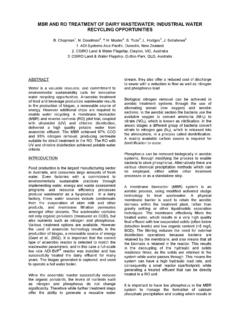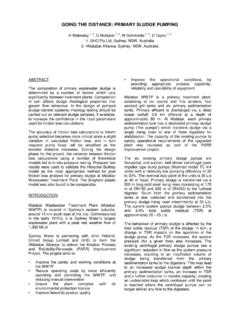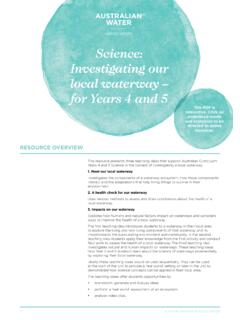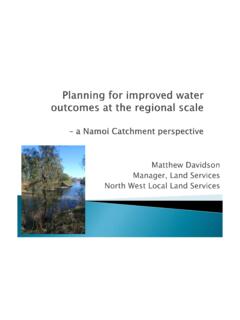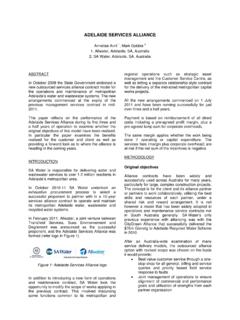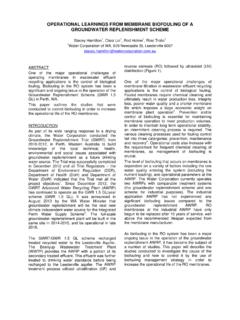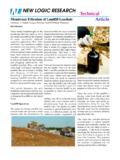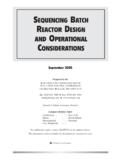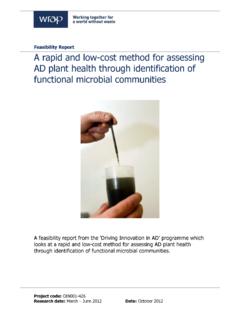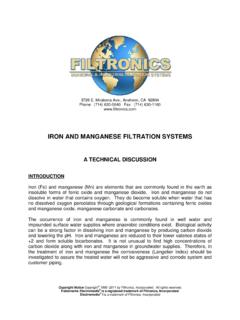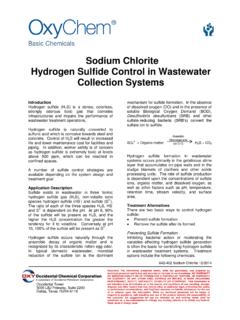Transcription of BIOLOGICAL PHOSPHORUS REMOVAL: WHERE …
1 BIOLOGICAL PHOSPHORUS removal : WHERE HAS IT BEEN, WHERE IS IT GOING? Peter Griffiths pH Water Consultants Pty Ltd ABSTRACT BIOLOGICAL based systems for the removal of PHOSPHORUS removal have been implemented within Australia since the early 1980 s. Despite significant international and local research, the performance of these types of plants has been, and continues to be, somewhat variable. With the looming PHOSPHORUS crisis and the nutrient deficient nature of Australian soils, we cannot continue to accept poor performance of these plants that are potentially a significant source of reusable PHOSPHORUS compared to chemical PHOSPHORUS removal systems.
2 Action is required to provide more effective and lower cost systems. Potential areas of optimisation of current process design procedures are identified. INTRODUCTION Australia is faced with somewhat unique municipal sewage characteristics in that influent nitrogen loads per capita are generally higher than those experienced globally in developed countries. Similarly, the per capita PHOSPHORUS loads are equal to, if not greater than those for other similar developed countries. Technically, this makes the provision of BIOLOGICAL systems achieving the required low effluent nitrogen and PHOSPHORUS concentrations more challenging.
3 BIOLOGICAL based systems for the reduction of effluent PHOSPHORUS concentrations have been implemented within Australia since the early 1980 s. Despite significant international and local research, the performance of these types of plants has been, and continues to be, somewhat variable. The impediments to the provision of effective BIOLOGICAL nutrient reduction systems include both technical and non-technical factors. The technical factors include such issues as the variety of enhanced BIOLOGICAL nutrient removal processes available (more than half a dozen public domain processes and many more proprietary systems), plus the impact of the temperature ranges experienced in Australia.
4 In addition, not all aspects of the process design are definitive with engineering judgement applied to some components such as anaerobic zones and internal recirculation rates. The outcome of all of these factors is that, despite some very successful plants being implemented within Australia, the full potential of the BIOLOGICAL nutrient removal process has not yet been fully realised in terms of maximum cost effectiveness and optimum performance. In order for Enhanced BIOLOGICAL PHOSPHORUS reduction (EBPR) to be economically competitive compared to alternative chemical PHOSPHORUS reduction processes, the increase in treatment volume associated with the provision of additional facilities such as anaerobic zones must be minimised.
5 The intention of this paper is to highlight those processes and features that have proven critical to successful plants. More importantly, the essential design data required to better optimise design and operation to minimise capital and operating costs are identified. Based on this, potential research areas are presented that should provide significant economic benefits to the Australian water industry and, potentially, permit Australia to be a source of expertise for the international water industry. DISCUSSION Considerations in Design of Enhanced BIOLOGICAL PHOSPHORUS removal Plants There are numerous factors impacting on the cost and performance of an enhanced BIOLOGICAL PHOSPHORUS reduction facilities (EPBR).
6 These include obvious factors such as temperature and design influent loads. However, once these are established, the key factors become; Process configuration Sludge Age or Solids Retention Time The range of process configurations available are briefly reviewed. The factors contributing to the determination of the minimum sludge age are then reviewed in detail to demonstrate the impact on costs and performance. Areas of potential further investigation or research are highlighted to identify WHERE improved performance and/or reduced capital and operating costs would be a benefit.
7 Process Configuration Optimisation A broad range of process configurations exist to achieved EBPR. Almost all of these process configurations have, at their core, the Modified Ludzack Ettinger (MLE) process (Figure 1) for substantial nitrogen removal . Figure 1: Schematic of MLE process Utilising this core process, an anaerobic zone was added to achieve EBPR. In its most basic format, this was referred to as the 3 Stage Bardenpho process (also known as the A2O process and Phoredox Process) comprising an anaerobic zone, an anoxic zone and an aerobic zone.
8 This was the original EBPR process developed globally by Dr James Barnard. Figure 2: Schematic of 3 Stage Bardenpho process Initial application of this process was somewhat poor in terms of nitrogen removal and subsequent leakage of nitrate to the anaerobic zone then impacted on the extent of PHOSPHORUS reduction achieved. To better protect the anaerobic zone from nitrate leakage, the basic 3 Stage Bardenpho process was further refined by Dr Barnard. The 5 Stage Bardenpho process was proposed to increase nitrogen removal in order to better protect the anaerobic zone from nitrate leakage.
9 This process configuration involved the addition of a secondary anoxic zone and a small secondary aerobic zone after the main anoxic and aeration zones. The size and cost of the secondary treatment facilities was considerably increased due to the inclusion of these two additional zones. Figure 3: Schematic of 5 Stage Bardenpho process The 5 Stage Bardenpho process suffered a number of short comings including the need to supply supplemental substrate to the secondary anoxic zone therefore increasing operating costs. The configuration also experienced episodes of secondary PHOSPHORUS release in the secondary anoxic zone, negating any benefits from the enhanced BIOLOGICAL PHOSPHORUS removal .
10 Alternative process configurations to the initial Bardenpho configurations were also developed. The intention of all of these process configurations developed was to positively protect the anaerobic zone from nitrate leakge. The UCT process was developed by the University of Cape Town and incorporated an additional pre-anoxic zone and additional internal recirculation (R Recycle) of approximately one times ADWF to reduce or eliminate the discharge of nitrate to the anaerobic zone. Figure 4: Schematic of UCT process The UCT process did not, under all circumstances, prevent nitrate leakage to the anaerobic zone.
